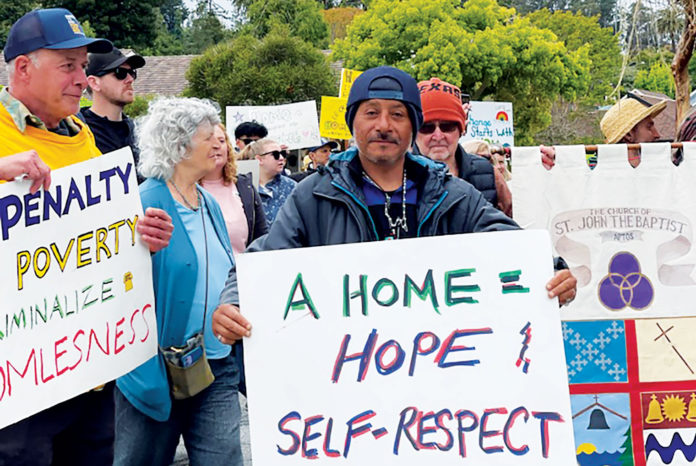
“171,000 people experience homelessness daily. California is home to… 30% of the nation’s homeless population, and half the nation’s unsheltered population.” —Kushel, Moore, et al., “Toward a New Understanding” (2023)
We all play musical chairs in Santa Cruz County because 80,000 new residents since 1980 chase only 26,000 new housing units (homelessactionpartnership.org). Measure J (1978) controlled growth by blocking suburban pipelines and SLV building permits—raising prices while fostering homelessness.
Liberals explain homelessness with low wages, racism, violence, mental illness and drug/alcohol abuse and they prescribe increasingly subsidized low-income housing projects and Section 8. Public-private “Low Income Housing Tax Programs” encourage huge investments in housing priced at a tolerable 30% of incomes. But can taxpayers afford to make housing a right for all comers?
Market champions might repeal Measure J zoning to help housing and hiring simultaneously while decreasing hiring paperwork (W-4s, Schedule H and licensed contracting) and welcoming underground pipes and ADUs. As leaders squabble over underfunded housing, tent cities discourage business. Without investments, taxes or even fresh coffee, how can financial life planning help wanderers?
Imagine sweet Rosetta, mother of two, at the average homeless age of 47 who, like most, grew up locally alongside an estimated 1,034 homeless Santa Cruz families. Let’s say she suffers depression from wife beating, takes to drinking and then meth and then loses her job and kids to Child Protective Services. She flees to a friend’s couch then, embarrassed, to the streets for safety only to get brutally brutalized and robbed of money and papers.
Kushel writes: “More than one third of all participants (38%) experienced either physical (36%) or sexual (10%) violence during this episode of homelessness.” She was arrested and hospitalized, then simply released to months of begging and sleeping outside. Rosetta had to crack a meth habit, which affected 31% of homeless. The starry night, garbage and bugs told her drugs and violence negated all her plans and she nightmared money helplessness from youth to find herself.
Disease kills more than hunger in America, and Rosetta soon found CalFresh food, Covered CA insurance, warmer clothing, a backpack and a tent at Abbot’s Thrift. Too young and able for Social Security, she collected unemployment, begged on streets and applied for general assistance and housing shelters. She could not receive phone calls or emails easily as she struggled for needed documents and transportation problems kept her from jobs and housing. She lacked credit or savings (that emergency fund we all need) and wasted precious time protecting belongings while handling illness and bodily functions. When she failed to look and smell presentable, others refused work and help.
Shelters offer her showers, laundry and toilets. At Felton’s Mountain Community Resources (communitybridges.org/mcr), good case managers budgeted elementary financial plans alongside professional counseling to locate missing paperwork, food, medicine and shelter. For risk avoidance, Narcotics Anonymous helped with codependency and addiction as empathetic listening to frank conversations healed.
A borrowed book, “Siddhartha” by Hermann Hesse, lauded a wandering beggar job applicant who shrewdly said, “I can think, I can wait, I can fast.” Siddhartha had abandoned poverty with a vision of romance, and she dreamt of reclaiming her kids from group homes; life planning means dreaming of healthy life then creating its financial architecture.
Rosetta could think, so she organized physical things as she hoarded papers and cash by percentage into dream buckets: she weeded yards and cleaned dishes. She spurned Home Depot job lines, but waited patiently at countless small businesses as she starved herself of luxuries to recover and save in dream buckets organized by percent earned.
She accepted crisis shelters like Monarch Services: “Participants who stayed in shelters reported general satisfaction with them; many who didn’t expressed concerns about curfews, the need to vacate during the day, health risks and rules.”
Self-discovery, elementary financial therapy and bucket budgeting are financial life planning that helped Rosetta leverage a beater car and rental deposits. With no college, she found that a notary license opened worlds of business as the modest salary qualified her for an ADU home. Emergency activities ended, so now she considers enhanced financial planning: investments, taxes, insurance, etc.
Felton neighbors admired her story and she was last seen in court fighting for her children.
Robert Arne, EA, CFP, MS, of Carpe Diem Financial Life Planning, gives holistic financial advice as his client’s fee-only fiduciary. He serves mostly Santa Cruz Mountain dwellers. These articles must not be read as personal financial, mortgage, tax or investment advice; consult appropriate professionals. Learn more at www.carpediem.financial.












